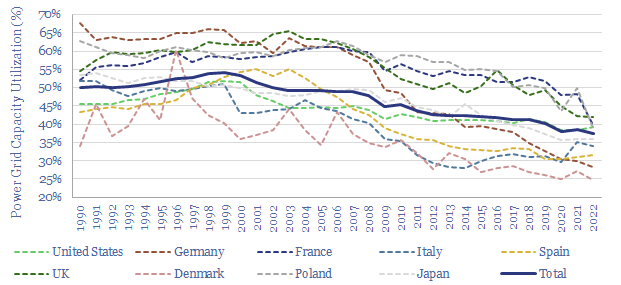There is an economic paradox where shifting towards lower cost supply sources can cause inflation in the total costs of supply. Renewable-heavy grids are subject to this levelized cost paradox, as they have high fixed costs and falling utilization. As power prices rise, there are growing incentives for self-generation. Energy transition requires a balanced approach.
If you rent an apartment for $100 per night, and then you also start renting a second apartment for $50 per night, then your total rental costs go up by 50%, not down by 50%. The simple levelized cost of the second apartment is 50% lower than the first. But overall costs rise as the costs of the first apartment are fixed, and renting the second apartment erodes the utilization rate of the first one. Similar examples of ‘inverse deflation’ are contrasted on page 2 of this 12 page report.
Renewable heavy grids may also be prone to this levelized cost paradox. Power grids have fixed costs (e.g., per GW of capacity, including due to statutory rate of return regulation). Renewables reduce grid utilization rates because their load factors are low and their output is volatile. Unit costs rise when fixed costs are spread across lower utilization. Some countries that ramped renewables fastest now have some of the highest power prices (data here). Facts and figures on pages 3-6.
A deep dive into grid utilization rates? The average developed world power grid had a utilization factor of 55% at peak in 1998, which has since decreased to 38% in 2022 (chart above, data here). Reasons for the decline in grid utilization are on pages 7-8.
What consequences from this levelized cost paradox? We expect rising power prices and inflation (page 9), growing incentives for power consumers to disconnect from the grid and self-generate where they can (page 10), tightening demand for several capital goods categories (also on page 10) and resultant feedback loops that further elevate electricity prices for remaining power grid customers (page 11).
Achieving an energy transition requires a balanced and pragmatic approach. Our top five suggestions are spelled out on pages 12-13.
To be 100% clear, this note is not ‘anti-renewables’. Far from it. Wind and solar generation must rise 8.5x in our roadmap to net zero, to reach 30,000 TWH of supply in 2050, or 25% of all useful energy supplies. This note is simply anti-oversimplified levelized cost analysis. Rather, we think that a balanced, pragmatic ‘all of the above’ approach is more likely to accelerate real decarbonization progress.
